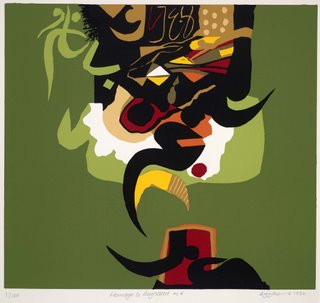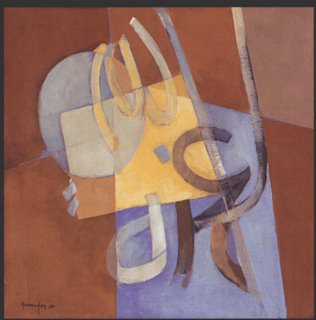
left: 'Homage to Baghdad' by Dia al-Azzawi
The exhibition ‘Word Into Art: Artists of the Modern Middle East’, which opened at the British Museum last week, provides a wonderful opportunity to view the work of around 80 of the region’s most accomplished contemporary artists.
The exhibition, which runs until September 2, has been organised in partnership with Dubai Holding. This is the first time the British Museum has put on show the impressive collection of modern art from the Middle East it has built up over a quarter of a century.
The museum’s director Neil MacGregor says: “We wanted to show that the Middle East is in London, and not just as a temporary phenomenon. Many of the artists in this exhibition are partly resident in London, which has become over the past 30 or 40 years one of the cultural capitals of the Middle East. That is something we should take notice of and celebrate and put on display.”
MacGregor points out that the exhibition is to be made available in a “virtual form” so that it can be seen and studied in the Middle East by those who may be prevented (by for example by the all-too-prevalent visa problems) from viewing it in London.
The exhibition’s curator Venetia Porter describes it as “a tribute to the artists and to the extraordinary creativity that there is in the Middle East that people just don’t know about here. We’re hoping that by showing this work we’re going to be able to introduce people to what is a very vibrant tradition of modern art happening all over the region.”
She adds: “We would like people to come away from this exhibition realising that there is much more to the Middle East than what you read in newspapers or see on television screens.”
The strikingly-designed exhibition is arranged in four sections. The first, ‘Sacred Script’, illustrates the relationship between the Arabic script and Islam and the enduring vitality of the Islamic calligraphic tradition. The works in the second section, ‘Literature and Art’, include Iraqi artist Hassan Massoudy’s “Calligraphy” illustrating the poetry of al-Aqil. The third section, ‘Deconstructing the Word’, looks at the use of script in abstract art. One example is “Untitled” by Mahmoud Hammad, a pioneer of the Syrian artistic movement from the 1960s and the first Syrian artist to include Arabic letters in abstract composition (on right).
The third section, ‘Deconstructing the Word’, looks at the use of script in abstract art. One example is “Untitled” by Mahmoud Hammad, a pioneer of the Syrian artistic movement from the 1960s and the first Syrian artist to include Arabic letters in abstract composition (on right).
The final section, ‘Identity, History and Politics’, investigates the political, historic and social dimensions of the relationship between art and word. The bloody conflicts of the Middle East including Palestine, the Iran-Iraq war, Lebanon and the present war in Iraq are forcefully present in some of the works.
In her brightly coloured two-part work “Children of war, children of peace”, Palestinian artist Laila Shawa uses repeated images of a young boy from a refugee camp in Gaza to highlight the plight of Palestinian children. The Iraqi artist Dia al-Azzawi pays tribute in his lithograph “Homage to Baghdad” to his native city, placing Arabic letters over abstract shapes that echo ancient Iraqi sculptures. Egyptian artist Chant Avedissian’s work “Umm Kulthum’s Greatest Hits” presents various images of the diva with the titles of some of her most famous songs.
The exhibition, to which entry is free, is accompanied by a rich programme of events in a ‘Middle East Now’ season. The season includes conferences, workshops, films, literature, food, history and the performing arts.
Susannah Tarbush, Saudi Gazette 23 May 2006


No comments:
Post a Comment